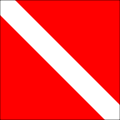- Diver down flag
-
A diver down flag, or scuba flag, is a flag used on the water to indicate that there is a diver below. It is red with a white stripe from the upper left corner to the lower right corner, and was designed and introduced in 1956 by Ted Nixon of U.S. Divers, from an idea of Navy veteran Denzel James Dockery.[1][2] It can be placed on a boat or on a surface marker buoy. Practice about this choice of flag is not uniform worldwide. In some countries, the practice is to use the Signal flag ALFA/ALPHA instead.
Contents
Purpose
It is used to notify to any boats to steer clear for the safety of the diver.
The use of this flag is required by law or regulation in many US states and Canada,[3] as well in several other countries in the world (e.g. Italy).[4] Usually the regulations require divers to display the flag and to stay within a specified distance of it when they are near the surface. As well there is often a larger zone around the flag where no boats are allowed to pass. Some states also prohibit the display of this flag when there is no diver in water.
Other uses
Today the red and white flag is so strictly associated with scuba diving that it is also used to indicate a place where there are services for divers, for example stores selling or renting diving equipment or scuba service stations. It may be seen on the windows or bumpers of cars belonging to divers.
Rock band Van Halen used the flag as the cover art of their 1982 album Diver Down.
Signal flag ALFA/ALPHA
 The "Alpha" or "Alfa" flag, meaning: "I have a diver down; keep well clear at slow speed"
The "Alpha" or "Alfa" flag, meaning: "I have a diver down; keep well clear at slow speed"
As a code signal the International maritime signal flags A (letter ALFA/ALPHA) has the meaning of "I have a diver down; keep well clear at slow speed",[5] used to indicate the presence of a diver in the water, and is more commonly employed in Europe and the British Commonwealth, including countries such as United Kingdom, Ireland, Australia, Canada, New Zealand, South Africa, and Kenya. It is also used by Russian Navy for the same purpose.
A rigid replica of the 'A' flag is required to be displayed by any vessel engaged in diving operations, when restricted in her ability to maneuver, if the size of the vessel makes it impractical to display the shapes and lights required by the International Rules for Prevention of Collisions at Sea (IRPCS) Rule 27.[6][7]
Although the presence of the 'A' flag may afford some protection for divers in the vicinity of the vessel displaying the flag, the intention of the rigid replica required by IRPCS Rule 27 (e) is to warn other vessels of the danger of collision. This marks a distinction between the 'A' flag and the red and white diver down flag.[8]
External links
- (EN) Diver down flag history
- Wallbank, Alister (2001). "Can anybody see me? (modified reprint from DIVER 2000; 45 (2) February: 72-74)". Journal of the South Pacific Underwater Medicine Society 31 (2): 116–119. http://archive.rubicon-foundation.org/7727. Retrieved 2008-10-13.
Notes
- ^ Cronje, Frans J (2007). "An Historic Overview of Recreational Scuba Diving.". In: Moon RE, Piantadosi CA, Camporesi EM (eds.). Dr. Peter Bennett Symposium Proceedings. Held May 1, 2004. Durham, N.C.: (Divers Alert Network): 6. http://archive.rubicon-foundation.org/9059. Retrieved 2011-01-13.
- ^ Richardson, Drew (1999). "A brief history of recreational diving in the United States.". South Pacific Underwater Medicine Society Journal 29 (3). http://archive.rubicon-foundation.org/6019. Retrieved 2011-01-13.
- ^ McMillan, Joseph (2001). "Maritime Warning Signals". Sea Flags. http://mysite.verizon.net/vzeohzt4/Seaflags/signals/warning.html. Retrieved 1 February 2010.
- ^ "Italian regulations about the Diver Down Flag" (in Italian). D.P.R. n° 1639 del 2 ottobre 1968. http://www.faoadriamed.org/pdf/Legislation/Italy/DPR%201639-1968.html. Retrieved 1 February 2010.
- ^ "U.S. Navy Signal Flags". United States Navy. 17 August 2009. http://www.navy.mil/navydata/navy_legacy_hr.asp?id=273. Retrieved 1 February 2010.
- ^ "Rule 27: Vessel not under command". U.S. Coast Guard Navigation Center. http://www.navcen.uscg.gov/?pageName=navRule&rule=Rule27. Retrieved 1 February 2010.
- ^ "IRPCS Rule 27". http://www.sailtrain.co.uk/Irpcs/rule27.htm. Retrieved 1 February 2010.
- ^ "Eighth Coast Guard District Special Notice to Mariners". United States Coast Guard. 2008. p. 23. http://www.uscg.mil/d8/waterways/docs/2008_special_notice_corrected.pdf. Retrieved 2 February 2010. "The distinction the Coast Guard wants to make clear is: The Alpha flag is a navigational signal intended to protect the vessel from collision. The sports diver flag is an unofficial signal that, through custom, has come to be used to protect the diver in the water."
Categories:
Wikimedia Foundation. 2010.

